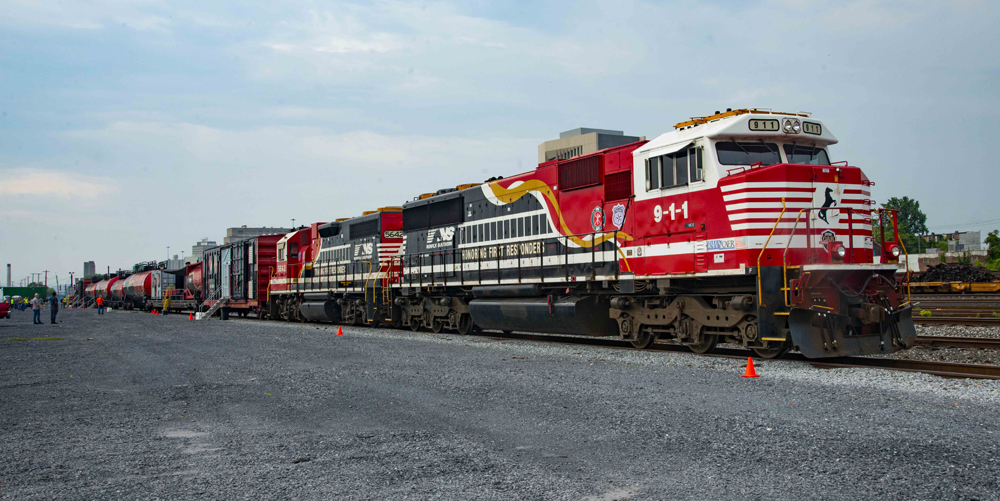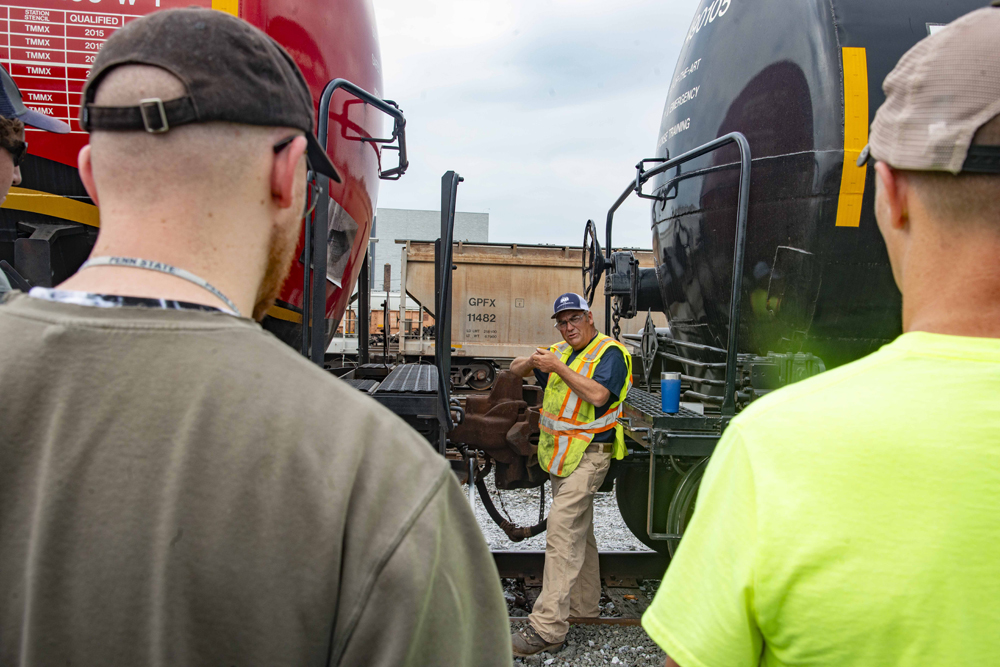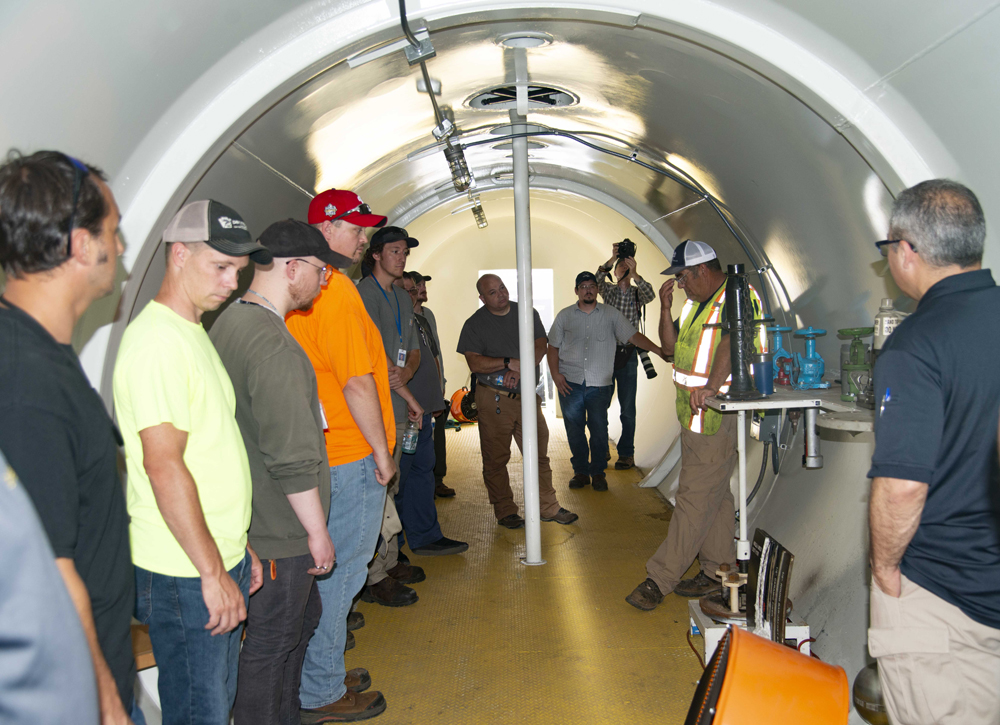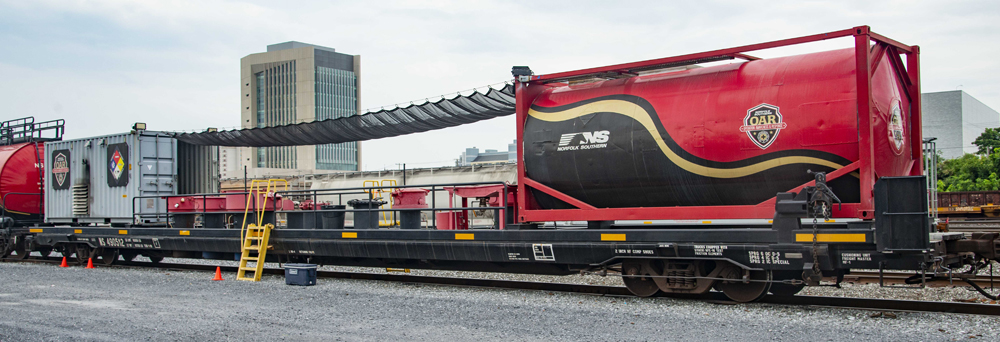
HARRISBURG, Pa. – Now in its eighth season, Norfolk Southern’s First Responders Train continues its mission of training 5,000 firefighters, emergency medical technicians, police and dispatchers each year at cities around NS’s 19,000-route-mile, 22-state system.
From March to October, the eight-car train circulates among 12 to 15 cities, offering free training in emergency procedures to heighten familiarity among first responders. It’s part of NS’s Operation Awareness & Response program, launched in 2015 to build bridges to emergency responders in Norfolk Southern communities. OAR is conducted in conjunction with TRANSCAER (Transportation Community Awareness and Emergency Response), a hazmat-response outreach program covering North America.

“It’s Railroading 101,” said Connor Spielmaker, NS senior communications manager. “A lot of these departments have training facilities with autos, but not trains, even if they have a railroad [running through] their back yard.”
This training has taken on added relevance in the wake of last February’s derailment of 38 cars of Train 32N and subsequent toxic-chemical spill at East Palestine, Ohio, on NS’s Fort Wayne Line main line, a key link in the railroad’s New York-Chicago route. So far, NS has spent $800 million to remediate the environmental, public-health, and economic impacts of that release, which are likely to continue for years.
NS CEO Alan Shaw visited the site Saturday, July 29, telling a Pittsburgh reporter, “In the immediate aftermath of the derailment, I was here, and I’ve come back almost every week since.”
This year’s route
Typically, the first-responder train stops in a city for three days of training, offering two classes a day, before heading to the next venue. This year, it began its journey with stops in Asheville, N.C.; Cincinnati; Columbus, Ohio; Birmingham, Ala.; Atlanta; Spartanburg, S.C.; Greenville, S.C.; and Roanoke, Va., before traveling north for a week in Harrisburg Yard. Next, it moves on to Toledo, Ohio; Ypsilanti, Mich.; Lorain, Ohio; Pitcairn, Pa. (Pittsburgh) and Morrisville, Pa. (Philadelphia).

As an added feature this year, the train spent three weeks in late March and early April at the former Nickel Plate Road yard in Bellevue, Ohio. The extended visit symbolized NS’s pledge to build a permanent systemwide hazmat-response training campus in Ohio, likely near East Palestine.
Last week, the train was parked in NS’s Harrisburg Yard for three days of classes for central Pennsylvania fire, police and ambulance personnel. The four-hour sessions begin with a 90-minute classroom meeting in one of two specially outfitted boxcars. Next are hands-on visits to two flatcars that are equipped with demonstration tank-car valves and fittings, four tank cars of varying sizes and types (one of which is converted for walk-through inspections), and a locomotive.
“We want to make sure firefighters are prepared,” said Spielmaker. When an incident occurs, he said NS wants them to know “how to come out, how to find us, and how to be safe.” Especially, he said, when the call comes “at 3 o’clock in the morning.
“We take the [basic emergency] training they get and apply that to the railroad.”
It makes a difference, he said, when firefighters already know the NS response team and have already had a hands-on experience with the rolling stock. For example, he said, “We put them in the locomotive cab so they see the confined space” in the event that they have to evacuate crewmembers.
In the past, the train has been powered by NS GP38-2 unit No. 5642, but in this case that unit was joined by NS SD60E unit No. 911. Both are painted in a red-white- and-black first-responder scheme, displaying OAR and TRANSCAER logos.
Tank car details

Other exercises include learning to differentiate among various kinds of tank cars, including high-pressure and low-pressure cars and insulated and non-insulated vessels. An insulated car may show damage to the outer jacket, but that doesn’t mean that the inner tank is breached, said George Bunker, a contractor with Marion Environmental Inc., an emergency-response consulting engineering firm that helps NS conduct training.
Mounted on the specially outfitted 89-foot flat cars are a wide variety of high-pressure and low-pressure valves and fittings, where trainees can examine them firsthand at ground level without the need to climb atop or underneath tank cars. Some, MEI instructor Andy Bailie pointed out, are designed to vent excess pressure under normal conditions, meaning that a seemingly leaking valve is not always a sign of danger.
Instructors described the function of shelf couplers in avoiding telescoping punctures of the tank ends of adjacent cars. Commodities carried in tank cars range from propane and carbon dioxide to corn syrup, acids, chlorine, crude oil, ethanol, and molten sulfur.
Among other topics covered are general heads-up awareness in an active railroad setting, and obtaining and interpreting shipping papers. These are especially important in identifying cars carrying either TIH (toxic inhalation hazard) or PIH (poison inhalation hazard) lading. Even a car shown on a wheel report as empty, instructors pointed out, usually contains a residue of the last-carried material, sometimes amounting to a few hundred gallons or more.
MEI instructor David Fentress noted the importance of locating a fuel-shutoff switch in the event of a locomotive fire and knowing how to drop a knife switch to kill electrical current, much of it flowing at 600 volts. He also cautioned trainees to let railroad employees handle any uncoupling of air-brake hose joints to avoid a severe uncontrolled kick around legs and knees.
NS offers the training to all levels of local, state and federal agencies. Last week’s event included both career and volunteer responders, including some from the Pennsylvania Department of Environmental Protection, the Cumberland County Emergency Management Agency, and Swatara Fire and Rescue Services.
“This is excellent training for the volunteer firefighters who protect our communities,” said Mary Klaus, president of Swatara Fire and Rescue.
In addition to the roving classroom train, NS offers customized training, ranging from local “table-top” sessions at a firehouse where volunteers can’t attend one of the train’s visits, all the way up to a mock accident scene, where responders suit up to battle a simulated release at one of the tank cars.
Interested agencies or responders can register for future sessions at http://www.joinnsoar.com/.
— Updated at 9:45 a.m. CDT to add byline














The state of Delaware needs to be visited since NS has a large presence and the Volunteer fire co’s needs this training.
That type of training has been around for years. Fancy it up now and you get good press coverage.
The folks in Lac Megantic could have used this training.
An extremely exemplary work that should never end! Congratulations NS!
Dr. Güntürk Üstün